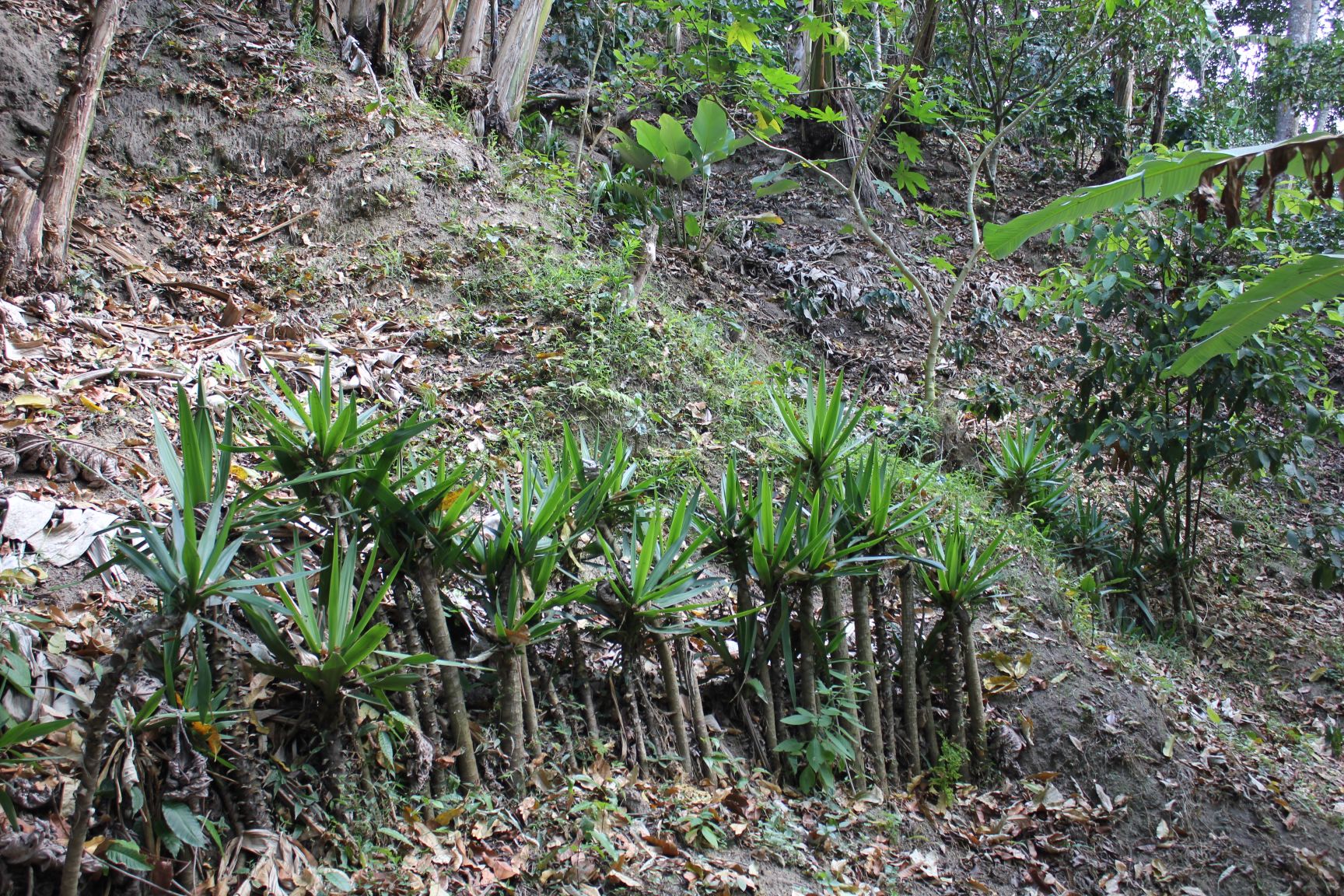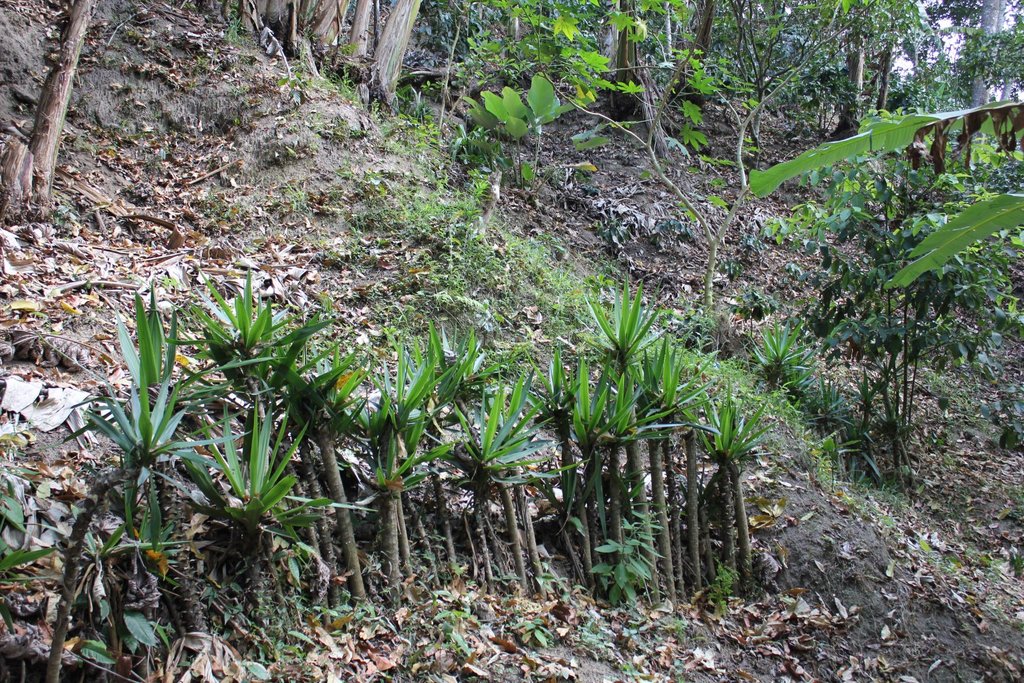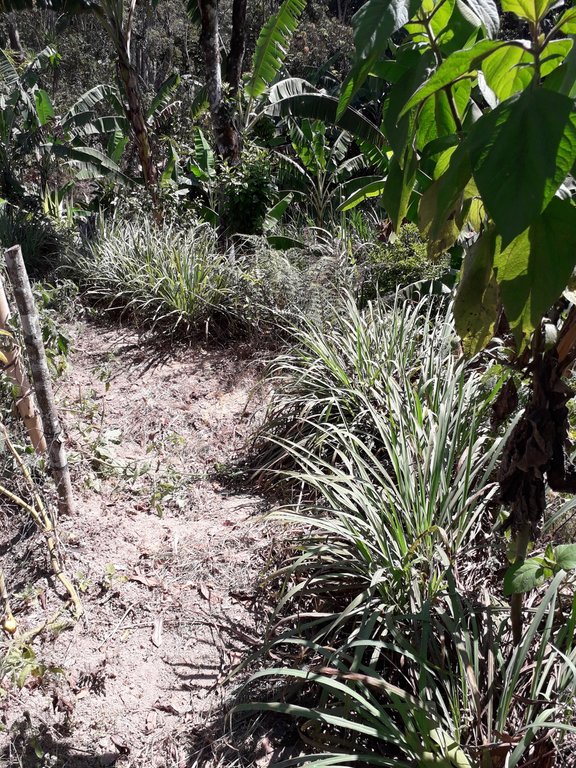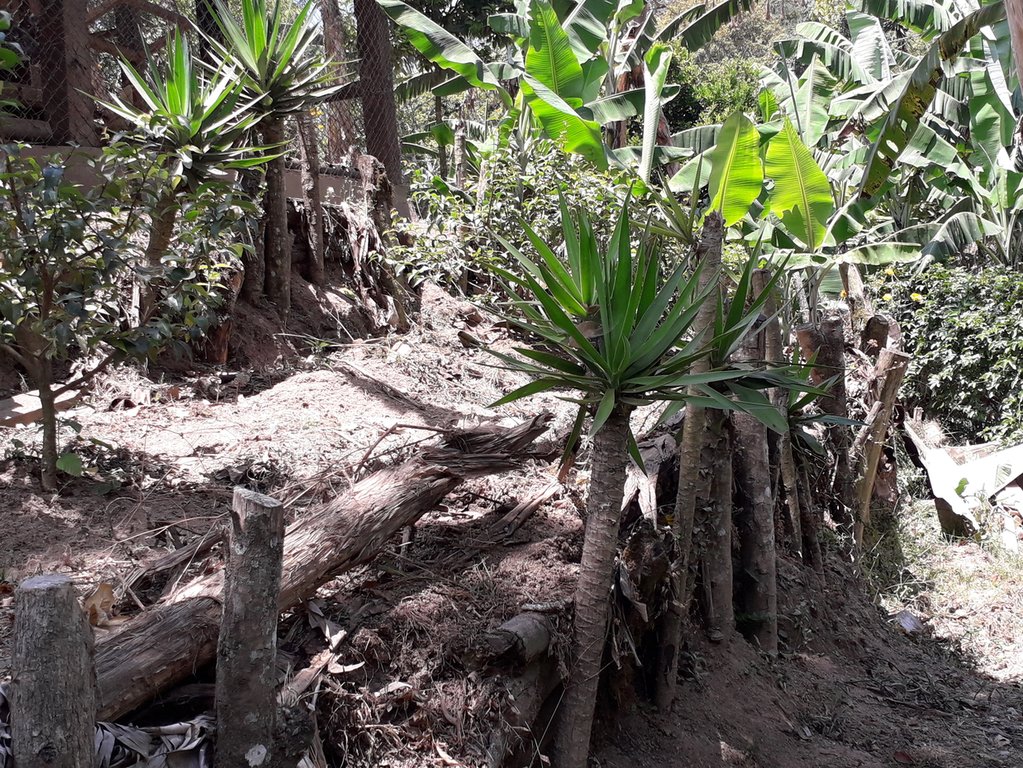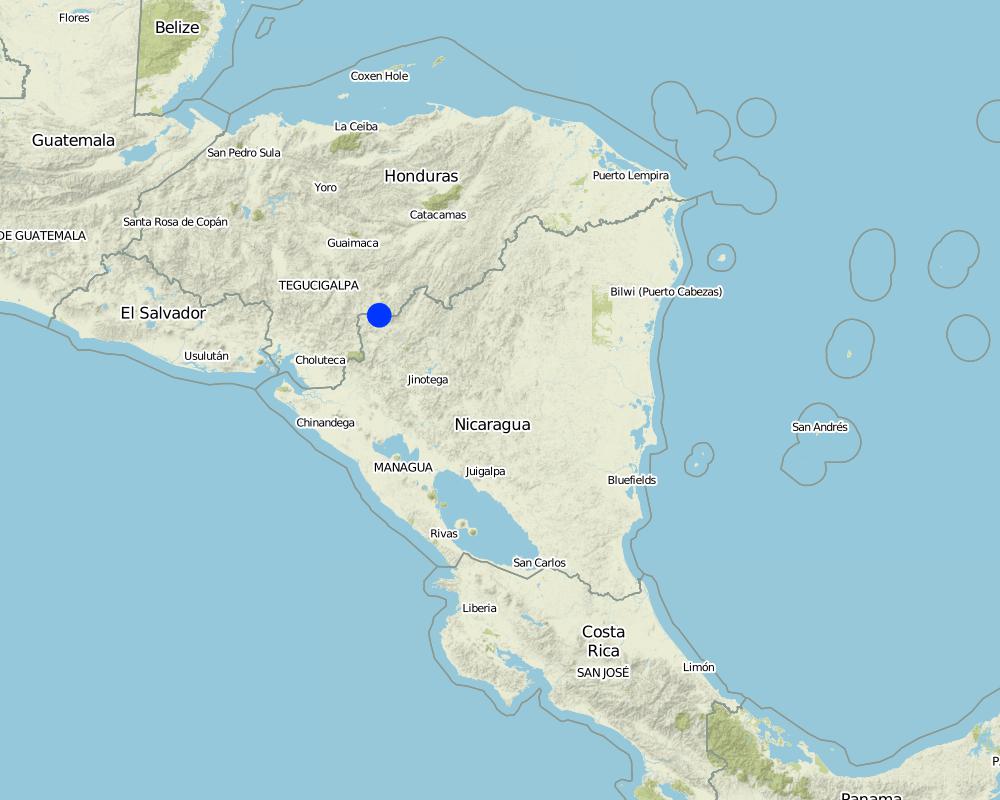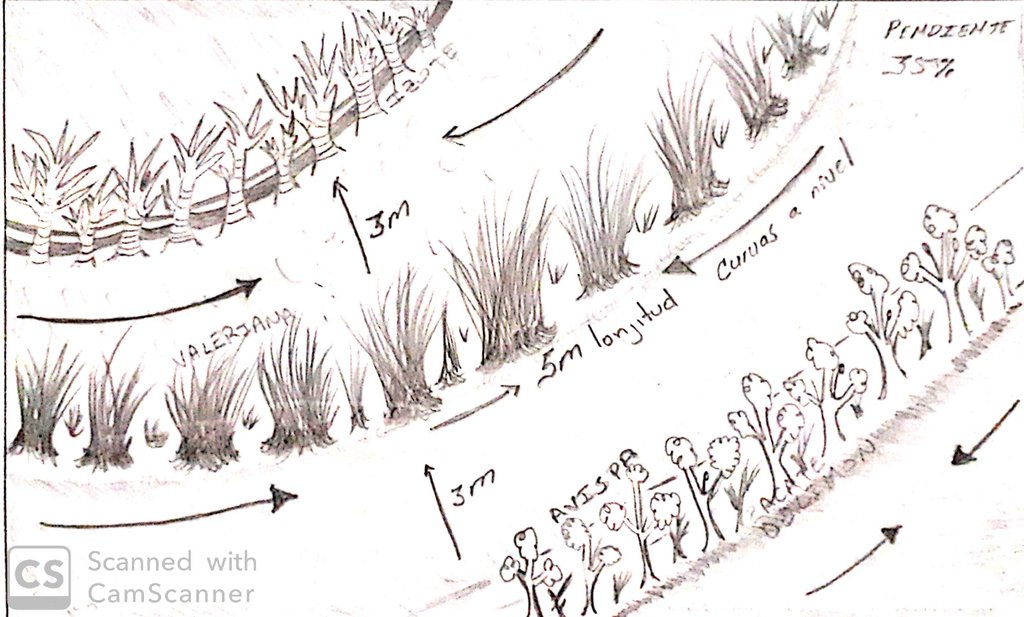Barreras vivas [Nicaragua]
- Creation:
- Update:
- Compiler: María Rodríguez
- Editor: –
- Reviewers: Johanna Jacobi, Alexandra Gavilano
Barreras vivas
technologies_4577 - Nicaragua
View sections
Expand all Collapse all1. General information
1.2 Contact details of resource persons and institutions involved in the assessment and documentation of the Technology
Key resource person(s)
land user:
Lovo Salgado Claudia Rebeca
Nicaragua
land user:
Bautista Benito
Nicaragua
SLM specialist:
Name of project which facilitated the documentation/ evaluation of the Technology (if relevant)
Para el mandato de backstopping para le programa gestion comunitaria de la cuenca de Rio Dipilto en Nicaragua (Gestion comunitaria - Nicaragua)Name of the institution(s) which facilitated the documentation/ evaluation of the Technology (if relevant)
Ministerio del Ambiente y los Recursos Naturales - Nicaragua (MARENA) - NicaraguaName of the institution(s) which facilitated the documentation/ evaluation of the Technology (if relevant)
SDC Swiss Agency for Development and Cooperation (SDC Swiss Agency for Development and Cooperation) - Switzerland1.3 Conditions regarding the use of data documented through WOCAT
The compiler and key resource person(s) accept the conditions regarding the use of data documented through WOCAT:
Yes
1.4 Declaration on sustainability of the described Technology
Is the Technology described here problematic with regard to land degradation, so that it cannot be declared a sustainable land management technology?
No
2. Description of the SLM Technology
2.1 Short description of the Technology
Definition of the Technology:
Las barreras vivas consisten en hileras de material vegetativo, que se establecen en contra de la pendiente y sirven para la retención de suelo en pendientes pronunciadas.
2.2 Detailed description of the Technology
Description:
Las barreras vivas se implementan en terrenos con pendientes pronunciadas y descubiertas de vegetación (susceptibles a la erosión). Está práctica contribuye a la retención de suelo, mantiene la humedad, reduce erosión hídrica, sirve como cortina rompeviento, como hospederos mejorando el hábitat. Se puede establecer con diferentes especies vegetativas propias de la zona que presenten características de buena adaptabilidad, resistencia a cambios de temperaturas, fenómenos climáticos como huracanes o seguías y el sistema radicular permite un buen anclaje en el suelo. Se recomienda no mezclar diferentes especies en una barrera viva con el objetivo de tener mayor uniformidad. Por ejemplo en la finca "El Árbol" ubicada en el municipio de Dipilto se utiliza como material vegetativo: Izote (Yucca gigantea), flor de avispa (Hibisco sp.), zacate de limón (Cymbopogon citratus), valeriana (Valeriana officinalis), bambú (Phyllostachys aurea) , pasto taiwán (Pennisetum purpureum) y caña de azúcar (Saccharum officinarum). Para el establecimiento de esta obra de conservación el primer paso es trazar las curvas a nivel en el terreno con ayuda de una herramienta conocida como aparato A, luego escoger el material vegetativo adaptado a la zona y proceder a establecerlo conforme al trazo de la curva a nivel. Los usuarios adoptan la tecnología de manera fácil ya que no requieren gastos mayores para adquirir el material vegetativo.
2.3 Photos of the Technology
2.5 Country/ region/ locations where the Technology has been applied and which are covered by this assessment
Country:
Nicaragua
Region/ State/ Province:
Zona Norte
Further specification of location:
Nueva Segovia-Dipilto
Specify the spread of the Technology:
- evenly spread over an area
If the Technology is evenly spread over an area, specify area covered (in km2):
40.0
If precise area is not known, indicate approximate area covered:
- 10-100 km2
Is/are the technology site(s) located in a permanently protected area?
Yes
If yes, specify:
Está ubicada en la Cordillera Dipilto y Jalapa.
Map
×2.6 Date of implementation
If precise year is not known, indicate approximate date:
- less than 10 years ago (recently)
2.7 Introduction of the Technology
Specify how the Technology was introduced:
- through land users' innovation
- through projects/ external interventions
Comments (type of project, etc.):
La propietaria realiza esta obra de conservación desde un período de tres años que la adquirió.
3. Classification of the SLM Technology
3.1 Main purpose(s) of the Technology
- reduce, prevent, restore land degradation
- conserve ecosystem
- protect a watershed/ downstream areas – in combination with other Technologies
- reduce risk of disasters
3.2 Current land use type(s) where the Technology is applied
Land use mixed within the same land unit:
Yes
Specify mixed land use (crops/ grazing/ trees):
- Agroforestry

Cropland
- Annual cropping
- Perennial (non-woody) cropping
- Tree and shrub cropping
Annual cropping - Specify crops:
- medicinal/ aromatic/ pesticidal plants and herbs
Perennial (non-woody) cropping - Specify crops:
- banana/plantain/abaca
Tree and shrub cropping - Specify crops:
- coffee, shade grown
Specify:
PERMANENTE
Is intercropping practiced?
Yes
If yes, specify which crops are intercropped:
Son el café, musáceas y frutales.
Is crop rotation practiced?
No

Settlements, infrastructure
- Settlements, buildings
Remarks:
Es una comunidad donde la infraestructura son la vivienda principal de la finca y casa de los comunitarios.

Waterways, waterbodies, wetlands
- Drainage lines, waterways
- Ponds, dams
Main products/ services:
Retención de sedimentación y anclaje del suelo para evitar deslizamientos.
3.3 Has land use changed due to the implementation of the Technology?
Has land use changed due to the implementation of the Technology?
- No (Continue with question 3.4)
3.4 Water supply
Water supply for the land on which the Technology is applied:
- mixed rainfed-irrigated
3.5 SLM group to which the Technology belongs
- agroforestry
- improved ground/ vegetation cover
- ecosystem-based disaster risk reduction
3.6 SLM measures comprising the Technology

vegetative measures
- V1: Tree and shrub cover
3.7 Main types of land degradation addressed by the Technology

soil erosion by water
- Wt: loss of topsoil/ surface erosion
- Wg: gully erosion/ gullying
- Wr: riverbank erosion

biological degradation
- Bc: reduction of vegetation cover
3.8 Prevention, reduction, or restoration of land degradation
Specify the goal of the Technology with regard to land degradation:
- prevent land degradation
- restore/ rehabilitate severely degraded land
4. Technical specifications, implementation activities, inputs, and costs
4.1 Technical drawing of the Technology
Technical specifications (related to technical drawing):
Las barreras vivas se establecen conforme la pendiente del terreno, las dimensiones va en dependencia de la cantidad en metros líneales que desee proteger, la distancia de siembra del material vegetativo sera según sus características ejemplo: el izote se recomienda establecerse a una distancia entre planta y planta no mayor de 10cm con el objetivo que minimice espacio en su desarrollo y sirvan de barrera de contención.
Author:
Wilton Francisco Cruz
Date:
21/03/2019
4.2 General information regarding the calculation of inputs and costs
Specify how costs and inputs were calculated:
- per Technology unit
Specify unit:
metros lineales
Specify dimensions of unit (if relevant):
5
Indicate average wage cost of hired labour per day:
210 cordoba
4.3 Establishment activities
| Activity | Timing (season) | |
|---|---|---|
| 1. | Limpieza del área. | Antes de la siembra de los cultivos anuales. |
| 2. | Cálculo de pendiente. | Antes de la siembra de los cultivos anuales. |
| 3. | Trazar lineas a nivel. | Antes de la siembra de los cultivos anuales. |
| 4. | Ahoyado. | Antes de la siembra de los cultivos anuales. |
| 5. | Siembra de material vegetativo. | Antes de la siembra de los cultivos anuales. |
Comments:
Se recomienda establecer las barreras vivas en el último mes del período seco, en el caso de la zona de Dipilto corresponde al mes de abril .
4.4 Costs and inputs needed for establishment
| Specify input | Unit | Quantity | Costs per Unit | Total costs per input | % of costs borne by land users | |
|---|---|---|---|---|---|---|
| Labour | D/H | 2.0 | 210.0 | 420.0 | 100.0 | |
| Equipment | machete | 1.0 | 150.0 | 150.0 | 100.0 | |
| Equipment | piocha | 1.0 | 350.0 | 350.0 | 100.0 | |
| Equipment | pala | 1.0 | 280.0 | 280.0 | 100.0 | |
| Equipment | barra | 1.0 | 750.0 | 750.0 | 100.0 | |
| Plant material | rastrillo | 1.0 | 170.0 | 170.0 | 100.0 | |
| Plant material | azadón | 1.0 | 200.0 | 200.0 | 100.0 | |
| Plant material | palin | 1.0 | 270.0 | 270.0 | 100.0 | |
| Plant material | izote | estacas | 25.0 | 5.0 | 125.0 | 100.0 |
| Total costs for establishment of the Technology | 2715.0 | |||||
| Total costs for establishment of the Technology in USD | 2715.0 | |||||
4.5 Maintenance/ recurrent activities
| Activity | Timing/ frequency | |
|---|---|---|
| 1. | Renovar vegetación | Anual |
| 2. | Poda | Anual |
Comments:
La poda es en dependencia del crecimiento del material vegetativo que se utilice.
4.6 Costs and inputs needed for maintenance/ recurrent activities (per year)
| Specify input | Unit | Quantity | Costs per Unit | Total costs per input | % of costs borne by land users | |
|---|---|---|---|---|---|---|
| Labour | Poda | D/H1 | 1.0 | 210.0 | 210.0 | 100.0 |
| Equipment | Machete | 1.0 | 150.0 | 150.0 | 100.0 | |
| Equipment | Palin | 1.0 | 270.0 | 270.0 | 100.0 | |
| Equipment | Barra | 1.0 | 750.0 | 750.0 | 100.0 | |
| Plant material | Estacas de izote | estacas | 15.0 | 25.0 | 375.0 | 100.0 |
| Total costs for maintenance of the Technology | 1755.0 | |||||
| Total costs for maintenance of the Technology in USD | 1755.0 | |||||
5. Natural and human environment
5.1 Climate
Annual rainfall
- < 250 mm
- 251-500 mm
- 501-750 mm
- 751-1,000 mm
- 1,001-1,500 mm
- 1,501-2,000 mm
- 2,001-3,000 mm
- 3,001-4,000 mm
- > 4,000 mm
Specify average annual rainfall (if known), in mm:
1800.00
Indicate the name of the reference meteorological station considered:
Privada
Agro-climatic zone
- sub-humid
Zona subhumeda, país trópical.
5.2 Topography
Slopes on average:
- flat (0-2%)
- gentle (3-5%)
- moderate (6-10%)
- rolling (11-15%)
- hilly (16-30%)
- steep (31-60%)
- very steep (>60%)
Landforms:
- plateau/plains
- ridges
- mountain slopes
- hill slopes
- footslopes
- valley floors
Altitudinal zone:
- 0-100 m a.s.l.
- 101-500 m a.s.l.
- 501-1,000 m a.s.l.
- 1,001-1,500 m a.s.l.
- 1,501-2,000 m a.s.l.
- 2,001-2,500 m a.s.l.
- 2,501-3,000 m a.s.l.
- 3,001-4,000 m a.s.l.
- > 4,000 m a.s.l.
Indicate if the Technology is specifically applied in:
- not relevant
5.3 Soils
Soil depth on average:
- very shallow (0-20 cm)
- shallow (21-50 cm)
- moderately deep (51-80 cm)
- deep (81-120 cm)
- very deep (> 120 cm)
Soil texture (topsoil):
- coarse/ light (sandy)
Soil texture (> 20 cm below surface):
- coarse/ light (sandy)
Topsoil organic matter:
- medium (1-3%)
5.4 Water availability and quality
Ground water table:
> 50 m
Availability of surface water:
good
Water quality (untreated):
poor drinking water (treatment required)
Water quality refers to:
surface water
Is water salinity a problem?
No
Is flooding of the area occurring?
No
Comments and further specifications on water quality and quantity:
Está cuenca se caracteriza por no contar con mantos de agua subterráneos.
5.5 Biodiversity
Species diversity:
- medium
Habitat diversity:
- medium
Comments and further specifications on biodiversity:
Por el avance de la frontera agrícola han extinguido algunas especies.
5.6 Characteristics of land users applying the Technology
Sedentary or nomadic:
- Sedentary
Market orientation of production system:
- mixed (subsistence/ commercial)
Off-farm income:
- 10-50% of all income
Relative level of wealth:
- average
Individuals or groups:
- individual/ household
Level of mechanization:
- manual work
Gender:
- women
Age of land users:
- youth
5.7 Average area of land used by land users applying the Technology
- < 0.5 ha
- 0.5-1 ha
- 1-2 ha
- 2-5 ha
- 5-15 ha
- 15-50 ha
- 50-100 ha
- 100-500 ha
- 500-1,000 ha
- 1,000-10,000 ha
- > 10,000 ha
Is this considered small-, medium- or large-scale (referring to local context)?
- medium-scale
5.8 Land ownership, land use rights, and water use rights
Land ownership:
- individual, titled
Land use rights:
- individual
Water use rights:
- individual
Are land use rights based on a traditional legal system?
Yes
Specify:
Escritura privada
5.9 Access to services and infrastructure
health:
- poor
- moderate
- good
education:
- poor
- moderate
- good
technical assistance:
- poor
- moderate
- good
employment (e.g. off-farm):
- poor
- moderate
- good
markets:
- poor
- moderate
- good
energy:
- poor
- moderate
- good
roads and transport:
- poor
- moderate
- good
drinking water and sanitation:
- poor
- moderate
- good
financial services:
- poor
- moderate
- good
6. Impacts and concluding statements
6.1 On-site impacts the Technology has shown
Ecological impacts
Soil
soil loss
Comments/ specify:
Esta práctica contribuye a disminuir la pérdida del suelo.
Biodiversity: vegetation, animals
habitat diversity
Comments/ specify:
Sirven como hospederos de especies.
Climate and disaster risk reduction
landslides/ debris flows
Comments/ specify:
Por la capacidad de amarre de suelos inestables y propensos a deslizamientos.
6.2 Off-site impacts the Technology has shown
damage on public/ private infrastructure
Comments/ specify:
Obra de conservación que se utiliza para proteger suelos inestables .
6.3 Exposure and sensitivity of the Technology to gradual climate change and climate-related extremes/ disasters (as perceived by land users)
Gradual climate change
Gradual climate change
| Season | increase or decrease | How does the Technology cope with it? | |
|---|---|---|---|
| annual temperature | increase | very well |
Climate-related extremes (disasters)
Meteorological disasters
| How does the Technology cope with it? | |
|---|---|
| tropical storm | very well |
Climatological disasters
| How does the Technology cope with it? | |
|---|---|
| heatwave | very well |
| drought | well |
6.4 Cost-benefit analysis
How do the benefits compare with the establishment costs (from land users’ perspective)?
Short-term returns:
positive
Long-term returns:
positive
How do the benefits compare with the maintenance/ recurrent costs (from land users' perspective)?
Short-term returns:
very positive
Long-term returns:
very positive
6.5 Adoption of the Technology
- > 50%
Of all those who have adopted the Technology, how many did so spontaneously, i.e. without receiving any material incentives/ payments?
- 91-100%
6.6 Adaptation
Has the Technology been modified recently to adapt to changing conditions?
No
6.7 Strengths/ advantages/ opportunities of the Technology
| Strengths/ advantages/ opportunities in the land user’s view |
|---|
| Evita la erosión del suelo. |
| Mantiene humedad del suelo. |
| Sirven como cortinas rompevientos. |
| Strengths/ advantages/ opportunities in the compiler’s or other key resource person’s view |
|---|
| Práctica económica para el productor, porque se realiza con materiales de la unidad de producción. |
| Los resultados son a corto y largos plazos. |
| Contribuye a mejorar la estructura física del suelo. |
6.8 Weaknesses/ disadvantages/ risks of the Technology and ways of overcoming them
| Weaknesses/ disadvantages/ risks in the compiler’s or other key resource person’s view | How can they be overcome? |
|---|---|
| Que la finca no tenga el material vegetativo a establecerse y tenga que comprarlo. | Adquirirlo de otra propiedad y mantener diversidad de especie. |
7. References and links
7.1 Methods/ sources of information
- field visits, field surveys
01
- interviews with land users
01
- interviews with SLM specialists/ experts
01
When were the data compiled (in the field)?
21/03/2019
7.3 Links to relevant online information
Title/ description:
Barreras vivas INTA
URL:
http://www.inta.gob.ni/biblioteca/images/pdf/plegables/Brochure%20barreras%20vivas.pdf
Title/ description:
Barreras vivas FAO
URL:
http://coin.fao.org/coin-static/cms/media/10/13195641664990/barrerasfinal.pdf
Links and modules
Expand all Collapse allLinks
No links
Modules
No modules


